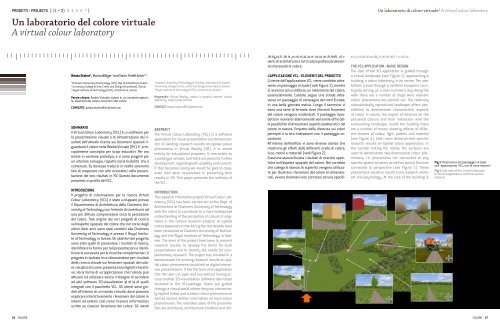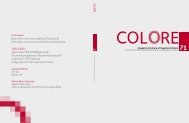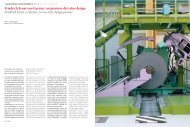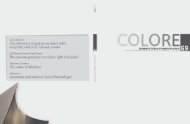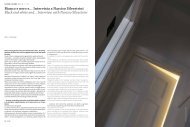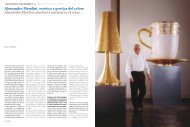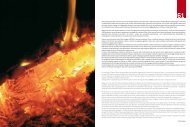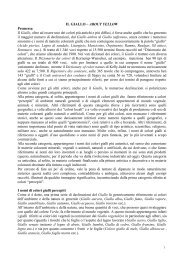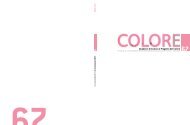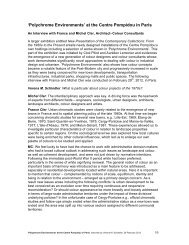Quaderni di Cultura e Progetto del Colore - Istituto Del Colore
Quaderni di Cultura e Progetto del Colore - Istituto Del Colore
Quaderni di Cultura e Progetto del Colore - Istituto Del Colore
Create successful ePaper yourself
Turn your PDF publications into a flip-book with our unique Google optimized e-Paper software.
PROGETTI / PROJECTS [ (1 + 2) 3 4 5 6 7 ]<br />
Un laboratorio <strong>del</strong> colore virtuale<br />
A virtual colour laboratory<br />
Beata Stahre 1 , MonicaBillger 1 and Karin Fri<strong>del</strong>l Anter 2,3<br />
1 Chalmers University ofTechnology (CTH), Dip. <strong>di</strong> Architettura, Svezia<br />
2 University College of Arts, Crafts and Design (Konstfack), Svezia<br />
3 Royal Institute of Technology (KTH), Architettura, Svezia<br />
Parole chiave: Realtà Virtuale, colore in un contesto spaziale,<br />
elasticità <strong>del</strong> colore, fenomeni <strong>del</strong> colore<br />
CONTATTO: beata.stahre@chalmers.se<br />
SOMMARIO<br />
Il Virtual Colour Laboratory (VCL) è un software per<br />
la presentazione visuale e la <strong>di</strong>mostrazione dei risultati<br />
<strong>del</strong>l’attuale ricerca sui fenomeni spaziali riguardanti<br />
il colore nella Realtà Virtuale (RV). E’ principalmente<br />
concepito per scopi educativi. Per ora<br />
esiste in versione prototipo, e vi sono progetti per<br />
un ulteriore sviluppo, rispetto sia la fruibilità che il<br />
contenuto. Se dovesse tradursi in realtà saremmo<br />
lieti <strong>di</strong> cooperare con altri ricercatori nella presentazione<br />
dei loro risultati in RV. Questo documento<br />
presenta un profilo <strong>del</strong> VCL.<br />
INTRODUZIONE<br />
Il progetto <strong>di</strong> informazione per la ricerca Virtual<br />
Colour Laboratory (VCL) è stato sviluppato presso<br />
il Dipartimento <strong>di</strong> Architettura <strong>del</strong>la Chalmers University<br />
of Technology con l’intento <strong>di</strong> contribuire ad<br />
una più <strong>di</strong>ffusa comprensione circa la percezione<br />
<strong>del</strong> colore. Trae origine dai vari progetti <strong>di</strong> ricerca<br />
sull’aspetto spaziale <strong>del</strong> colore che nel corso degli<br />
ultimi <strong>di</strong>eci anni sono stati condotti alla Chalmers<br />
University of Technology e presso il Royal Institute<br />
of Technology in Svezia. Gli obiettivi <strong>del</strong> progetto<br />
sono stati quelli <strong>di</strong> presentare i risultati <strong>di</strong> ricerca,<br />
identificare la forma per tali presentazioni e identificare<br />
le necessità per le ricerche complementari. Il<br />
progetto è risultato in un <strong>di</strong>mostratore per i risultati<br />
<strong>del</strong>la ricerca attuale sui fenomeni spaziali <strong>del</strong> colore<br />
visualizzati come presentazioni <strong>di</strong>gitali interattive.<br />
Ha la forma <strong>di</strong> un’applicazione che l’utente può<br />
attivare ed utilizzare senza il bisogno <strong>di</strong> accedere<br />
ad altri software 3D-visualization al <strong>di</strong> là <strong>di</strong> quelli<br />
integrati con il pacchetto VCL. Gli utenti sono guidati<br />
all’interno <strong>di</strong> un mondo virtuale, dove possono<br />
esplorare interattivamente i fenomeni <strong>del</strong> colore in<br />
interni ed esterni così come ricevere informazioni<br />
scritte su ciascun fenomeno <strong>del</strong> colore. Gli utenti<br />
1 Chalmers University of Technology (CTH), Dept. of Architecture, Sweden<br />
2 University College of Arts, Crafts and Design (Konstfack), Sweden<br />
3 Royal Institute of Technology (KTH), Architecture, Sweden<br />
Keywords: Virtual Reality, colour in spatial context, colour<br />
elasticity, colour phenomena<br />
CONTACT: beata.stahre@chalmers.se<br />
ABSTRACT<br />
The Virtual Colour Laboratory (VCL) is a software<br />
application for visual presentation and demonstration<br />
of existing research results on spatial colour<br />
phenomena in Virtual Reality (VR). It is meant<br />
mainly for educational purposes. It now exists as<br />
a prototype version, and there are plans for further<br />
development, regar<strong>di</strong>ng both usability and content.<br />
If this becomes reality we would be glad to cooperate<br />
with other researchers in presenting their<br />
results in VR. This paper presents the outlines of<br />
the VCL.<br />
INTRODUCTION<br />
The research information project Virtual Colour Laboratory<br />
(VCL) has been carried out at the Dept. of<br />
Architecture at Chalmers University of Technology<br />
with the intent to contribute to a more widespread<br />
understan<strong>di</strong>ng of the perception of colours. It originates<br />
in the various research projects on spatial<br />
colour appearance that during the last decade have<br />
been conducted at Chalmers University of Technology<br />
and the Royal Institute of Technology in Sweden.<br />
The aims of the project have been to present<br />
research results; to develop the forms for such<br />
presentations and to identify the needs for complementary<br />
research. The project has resulted in a<br />
demonstrator for existing research results on spatial<br />
colour phenomena visualized as <strong>di</strong>gital interactive<br />
presentations. It has the form of an application<br />
that the user can open and use without having access<br />
to other 3D-visualization software than those<br />
enclosed in the VCL-package. Users are guided<br />
through a virtual world, where they can interactively<br />
explore indoor and outdoor colour phenomena as<br />
well as receive written information on each colour<br />
phenomenon. The intended users of the presentation<br />
are architects, architectural students and oth-<br />
designati <strong>del</strong>la presentazione sono architetti, studenti<br />
<strong>di</strong> architettura e tutti coloro professionalmente<br />
interessati al colore.<br />
L’APPLICAZIONE VCL - ELEMENTI DEL PROGETTO<br />
L’utente <strong>del</strong>l’applicazione VCL viene condotto attraverso<br />
un paesaggio virtuale (ve<strong>di</strong> Figura 1), mentre<br />
si avvicina ad un e<strong>di</strong>ficio; un laboratorio <strong>del</strong> colore,<br />
essenzialmente. L’utente segue una strada attraverso<br />
un paesaggio <strong>di</strong> campagna <strong>del</strong> nord Europa,<br />
in una bella giornata estiva. Lungo il cammino vi<br />
sono una serie <strong>di</strong> fermate dove rilevanti fenomeni<br />
<strong>del</strong> colore vengono evidenziati. Il paesaggio riprodotto<br />
in maniera relativamente verisimile offre <strong>del</strong>le<br />
possibilità <strong>di</strong> <strong>di</strong>mostrare aspetti caratteristici <strong>del</strong><br />
colore in natura, l’impatto <strong>del</strong>la <strong>di</strong>stanza sui colori<br />
percepiti e la loro interazione con il paesaggio circostante.<br />
All’interno <strong>del</strong>l’e<strong>di</strong>ficio vi sono <strong>di</strong>verse stanze che<br />
mostrano gli effetti <strong>del</strong>le <strong>di</strong>fferenti scelte <strong>di</strong> colore,<br />
luce, motivi e materiali (ve<strong>di</strong> Figura 2).<br />
Ciascuna stanza illustra i risultati <strong>di</strong> ricerche specifiche<br />
sull’aspetto spaziale <strong>del</strong> colore. Nel corridoio<br />
che collega le stanze, le superfici vengono utilizzate<br />
per illustrare i fenomeni <strong>del</strong> colore bi-<strong>di</strong>mensionali,<br />
ovvero fenomeni non connessi ad una specifi-<br />
Un laboratorio <strong>di</strong> colore virtuale/ A virtual colour laboratory<br />
ers professionally interested in colour.<br />
THE VCL APPLICATION - BASIC DESIGN<br />
The user of the VCL-application is guided through<br />
a virtual landscape (see Figure 1), approaching a<br />
buil<strong>di</strong>ng; a colour laboratory, in its centre. The user<br />
follows a road through a northern European countryside<br />
setting, on a clear summer’s day. Along the<br />
walk there are a number of stops were relevant<br />
colour phenomena are pointed out. The relatively<br />
naturalistically reproduced landscape offers possibilities<br />
to demonstrate characteristic aspects<br />
of colour in nature, the impact of <strong>di</strong>stance on the<br />
perceived colours and their interaction with the<br />
surroun<strong>di</strong>ng landscape. Inside the buil<strong>di</strong>ng there<br />
are a number of rooms showing effects of <strong>di</strong>fferent<br />
choices of colour, light, pattern and material<br />
(see Figure 2). Each room demonstrates specific<br />
research results on spatial colour appearance. In<br />
the corridor linking the rooms, the surfaces are<br />
used to demonstrate two-<strong>di</strong>mensional colour phenomena,<br />
i.e. phenomena not connected to any<br />
specific spatial situation as well as optical illusions<br />
connected to perspective (see Figure 3). These<br />
phenomena visualize results from research within<br />
art and psychology. At the core of the buil<strong>di</strong>ng is<br />
Fig 1 Panoramica <strong>del</strong> paesaggio virtuale<br />
nell’-applicazione VCL, con le varie stazioni<br />
Fig 1 Overview of the virtual landscape<br />
in the VCLapplication, with the various<br />
stations.<br />
26 COLORE COLORE 27


